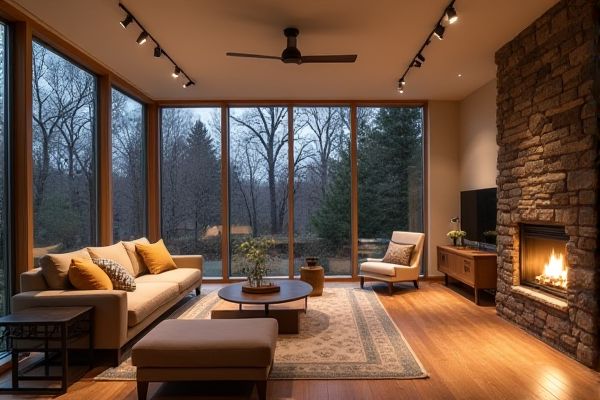
Layered lighting in a sunroom combines ambient, task, and accent lights to create a versatile and comfortable environment, whereas single-source lighting relies on just one fixture, often resulting in uneven illumination and limited functionality. Discover how optimizing your sunroom lighting can transform your space by reading the rest of the article.
Table of Comparison
| Lighting Type | Definition | Advantages | Disadvantages | Ideal Use in Sunroom |
|---|---|---|---|---|
| Layered Lighting | Combines ambient, task, and accent lights for versatile illumination. |
|
|
Creating balanced, mood-enhancing light suitable for multi-use sunrooms. |
| Single-Source Lighting | Uses one primary light source to illuminate the entire sunroom. |
|
|
Suitable for basic illumination in small or less-used sunrooms. |
Introduction to Sunroom Lighting
Layered lighting in sunrooms combines ambient, task, and accent lighting to enhance functionality and create a balanced atmosphere throughout the day and night. Single-source lighting relies on one primary fixture, which may lead to uneven illumination and limit versatility in sunroom activities such as reading, relaxing, or entertaining. Incorporating layered lighting strategies improves visual comfort, highlights architectural features, and ensures adaptability to changing natural light conditions.
What is Layered Lighting?
Layered lighting in a sunroom combines ambient, task, and accent lights to create a versatile and balanced environment that adjusts to different needs and moods. Unlike single-source lighting, which relies on one primary light fixture, layered lighting enhances functionality and aesthetic appeal by strategically placing multiple light sources at varying levels. Your sunroom benefits from improved brightness control, reduced glare, and an inviting atmosphere through this thoughtful approach to illumination.
Understanding Single-Source Lighting
Single-source lighting in a sunroom relies on one primary fixture, typically a ceiling-mounted or pendant light, providing uniform but limited illumination. This method often results in uneven light distribution and increased shadows, reducing the room's visual comfort and ambiance. Understanding the limitations of single-source lighting emphasizes the benefits of incorporating layered lighting to enhance brightness, depth, and functional zones within the sunroom.
Benefits of Layered Lighting in Sunrooms
Layered lighting in sunrooms enhances ambiance by combining ambient, task, and accent lights to create versatile illumination tailored to different activities and times of day. This approach improves visual comfort, reduces glare, and highlights architectural features and decor, making your sunroom more inviting and functional. Compared to single-source lighting, layered lighting offers better energy efficiency by enabling you to use only the necessary lights for each occasion.
Drawbacks of Single-Source Lighting
Single-source lighting in a sunroom often creates uneven illumination and harsh shadows, reducing visual comfort and ambiance. This lighting method limits flexibility in controlling light intensity and direction, which can negatively impact the room's functionality throughout the day. Reliance on a single light source also increases glare and energy consumption, making it less efficient than layered lighting solutions.
Flexibility and Functionality Comparison
Layered lighting in a sunroom enhances flexibility by combining ambient, task, and accent lights to create adaptable environments for various activities throughout the day. Single-source lighting often limits functionality by providing uniform illumination that may not satisfy specific needs like reading or entertaining. Your sunroom benefits from layered lighting's ability to tailor brightness and mood, maximizing usability and comfort.
Energy Efficiency Considerations
Layered lighting in a sunroom enhances energy efficiency by combining natural sunlight with strategically placed LED fixtures that reduce reliance on artificial lighting during the day. Single-source lighting often demands higher wattage and longer usage, increasing energy consumption and costs. You can optimize energy savings by integrating dimmable, energy-efficient bulbs with multiple layers of lighting tailored to your sunroom's usage patterns.
Aesthetic Impact on Sunroom Ambiance
Layered lighting in a sunroom enhances aesthetic impact by combining ambient, task, and accent lights, creating depth and visual interest throughout the space. Single-source lighting often results in flat illumination, limiting the room's ability to highlight architectural features or adjust mood effectively. By employing multiple light layers, sunrooms achieve a dynamic ambiance that complements natural daylight and enhances overall comfort and style.
Cost Factors: Layered vs Single-Source
Layered lighting in sunrooms typically incurs higher initial costs due to multiple fixtures, wiring, and installation complexity compared to single-source lighting, which usually involves just one central fixture. Ongoing energy expenses may also rise with layered systems as they require more bulbs and can increase electricity consumption if not managed efficiently. However, the flexibility and enhanced ambiance provided by layered lighting can justify the investment through improved usability and comfort.
Choosing the Right Lighting Approach for Your Sunroom
Choosing the right lighting approach for your sunroom involves understanding the benefits of layered lighting versus single-source lighting. Layered lighting combines ambient, task, and accent lights to create a versatile and balanced environment that enhances natural sunlight during the day and provides flexibility at night. Your sunroom will benefit from this approach by offering improved functionality, mood setting, and energy efficiency compared to relying on a single light source.
 homyna.com
homyna.com